by Robert A. Kraft, UPenn
(first presented publicly at the Oxford Patristics Conference, 23 Aug 1995)
These pieces are part of a miscellaneous collecton of papyri and related materials acquired by the University of Pennsylvania Museum around 1911 (see the History of the Collection). They were first flattened and photographed (black and white) by myself in April 1967 with the following notes:
Greek Codex fragments; very large book hand (Coptic traits?), in dark brown ink with letters slanted to the right.
Subsequently a photo was sent to C. H. Roberts, who kindly returned some notes on possible readings and the comment "I am by no means sure that it is a Christian text" (dated 1 Apr 1968). As it turned out, his readings of frg 2 proved less useful than my own.
That's pretty much where matters stood until 7 Feb 1973, when I discovered another similar frg among other unmounted materials from the same miscellaneous lot. Then, more than 20 years later it occurred to me that a search of the TLG using a program that allows me to ignore any blanks between words (on the IBYCUS System) would be appropriate, and in June of 1994, I was able to identify the following two patristic texts, but not all the frgs:
E16694 frg 1 written with the fibers ("recto") is an upper left corner, with margins preserved -- not yet identified
E16694 frg 1 written against the fibers("verso") is an upper right corner, with margins -- not yet identified
E16694 frg 2 recto (+ frg 5) proved to be from John Chrysostom In Matthew [PG 57.304-305]
?περβα?νει φιλοστοργ?αν. Το?το γ?ρ
01 κελε?ω, φησ?, δι’ ?τερον μ?ν ο?δ?ν, ?να δ?
02 ?μ?ς ?παλλ?ξω περιττ?ν φροντ?-
03 δων. Κ?ν γ?ρ σ?μερον μεριμν?σ?ς
04 ?π?ρ τ?ς α?ριον, κα? π?λιν α?ριον
05 μεριμν?σεις. Τ? ο?ν τ? περιττ?ν;
06 Τ? καταναγκ?ζεις τ?ν ?μ?ραν πλ?ον
07 τ?ς συγκεκληρωμ?νης α?τ?
08 ταλαιπωρ?ας καταδ?χεσθαι, κα?
09 μετ? τ?ν ο?κε?ων π?νων κα? τ?
τ?ς ?πιο?σης προστιθε?ς α?τ?
φορτ?ον, κα? τα?τα ο?δ?ν
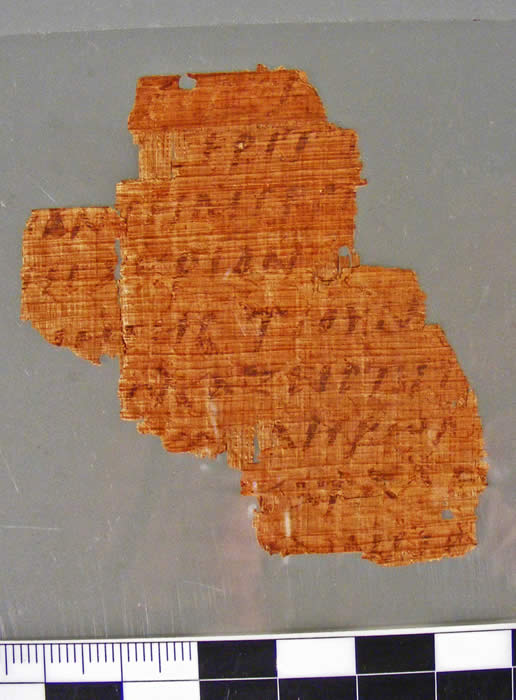
[about 25 lines missing before the fragment on the other side]
E16694 frg 2 verso (+ frg 5) ditto [PG 57.305]
τηλικο?των, ?με?ς ?π?ρ μ?ν το?των
01 μεριμν?μεν, ?π?ρ δ? τ?ν ?ν το?ς
02 ο?ρανο?ς ο?κ?τι, ?λλ’ ?ντεστρ?ψαμεν
03 τ?ν τ?ξιν, ?κατ?ρωθεν μαχ?μενοι
04 το?ς λεγομ?νοις. Σκ?πει γ?ρ· μ? ζητε?τε
05 τ? παρ?ντα, φησ?, καθ?λου· ?με?ς
06 δ? τα?τα ζητο?μεν διηνεκ?ς.
07 Ζητε?τε τ? ?πουρ?νια, φησ?ν·
08 ?με?ς δ? ο?δ? μικρ?ν ?ραν ?κε?να
ζητο?μεν, ?λλ’ ?σην ?π?ρ τ?ν
βιωτικ?ν ?πιδεικ- ν?μεθα τ?ν μ?ριμναν,
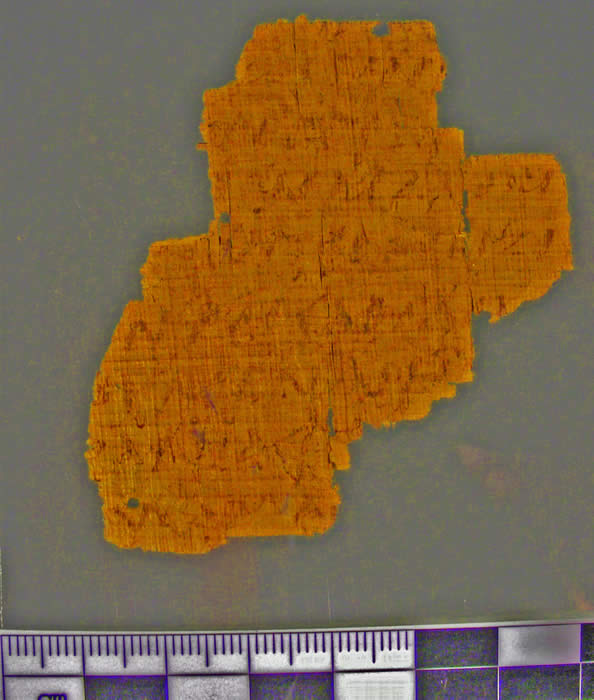
E16694 frgs 6 + 19 written along the fibers preserve a lower margin from Marcellus/Athanasius De Incarnatione et Contra Arianos [PG 26.1005 and 1008]; this identification was not discovered until the next leaf of the same text (below, frgs 3, 4, 11) had been identified. Since that next attested page (below, frgs 3, 4, 11) preserves fragments also written along the fibers from about 35 lines later in the same text, the present page (written || then --) could have been the first part of a bicolon (two joined pages from the middle of a quire, if the quire began ||) or more likely consecutive pages at the join between two quires. The first side of the present page (the joined frg of which is virtually illegible) should have ended about 35 lines above the second side, perhaps with the words [PG 26.1005.30]:
?ν τ? Ε?αγγελ?? λ?γει· Τ? γεγεννημ?νον
?κ τ?ς σαρκ?ς σ?ρξ ?στι, κα? τ?
γεγεννημ?νον ?κ το? Πνε?ματος πνε?μ? ?στι.
01 Κα? π?λιν· Τ? Πνε?μα ?που θ?λει, πνε?,
02 κα? τ?ν φων?ν α?το? ?κο?εις· ?λλ’
03 ο?κ ο?δας, π?θεν ?ρχεται, κα? πο?
04 ?π?γει. Ο?τως ?στ? π?ς ? γεγεννη-
[the lower margin is expected here, with the flip side beginning as below:
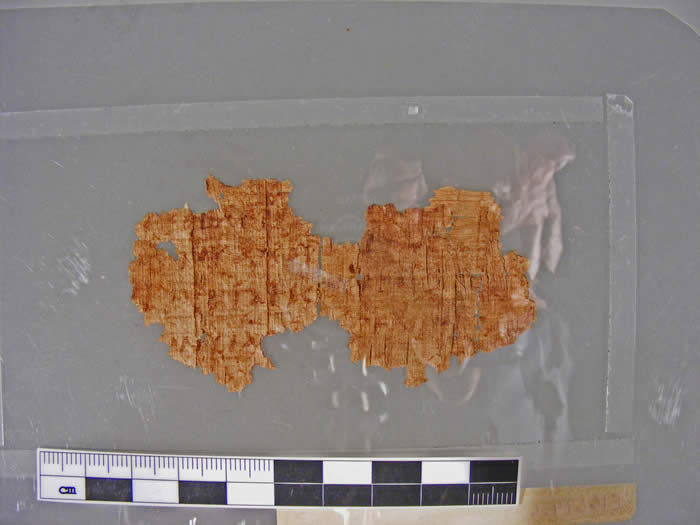
[new page, written along the fibers]
μ?νος ?κ το? Πνε?ματος. ?ν δ? τ? ?ρχ? το?
Ε?αγγελ?ου ?ω?ννης λ?γει· ?σοι δ? ?λαβον
α?τ?ν, ?δωκεν α?το?ς ?ξουσ?αν τ?κνα Θεο? . . .
. . . πολυτρ?πως π?λαι ? Θε?ς λαλ?σας
01 το?ς πατρ?σιν ?ν το?ς προφ?ταις, ?π’ ?σ-
02 χ?του το? ?μερ?ν το?των ?-
03 λ?λησεν ?μ?ν ?ν Υ??. Κα? ?λλαχο? λ?-
04 γει, ?τι ? Υ??ς λαλε?· Ε? δοκιμ?ν, φησ?,
[bottom margin]
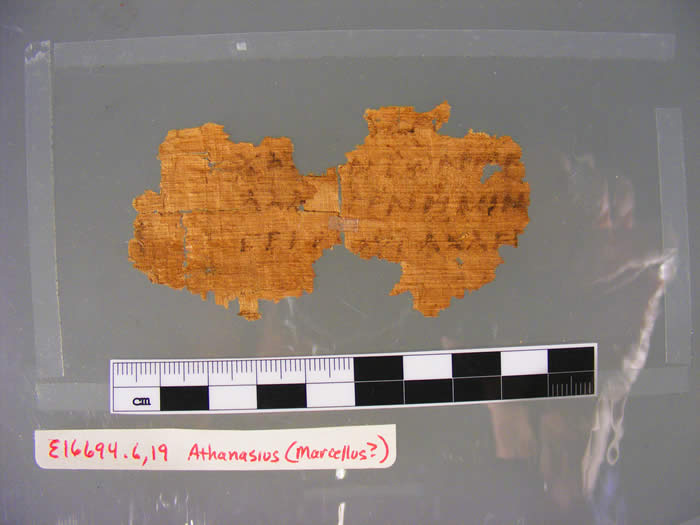
E16694 frgs 3 + 11 written along the fibers preserves a right margin and lower margin (frg 11), from the next page of Marcellus/Athanasius De Incarnatione [PG 26.1008]; frg 4 has parts of 3 lines from the left margin of the same page.
This page would have contained about 35 lines, beginning with the words
ζητε?τε το? ?ν ?μο? λαλο?ντος Χριστο?.
? δ? Υ??ς τ? Πνε?μα ε?πε τ? λαλο?ν ?ν το?ς . . .
. . . Ε? τις γ?ρ ?στι να?ς
01 το? Πνε?ματος, ο?τος να?ς ?στι το? Υ?ο? κα?
02 το? Πατρ?ς· ?που γ?ρ τ? Πνε?μα το? Θεο? κα
03 τοικε?, ?κε? ? Θε?ς κατοικε?. Κα?, ?σπερ
04 ? Πατ?ρ ?γε?ρει το?ς νεκρο?ς κα? ζωο
05 ποιε?, ο?τως κα? ? Υ??ς ο?ς θ?λει ζωο
06 ποιε?. ?μο?ως δ? κα? περ? το? Πνε?ματος
07 λ?γει, ?τι Τ? Πνε?μ? ?στι τ? ζωοποιο?ν,
08 ? σ?ρξ ο?κ ?φελε? ο?δ?ν. Πρ?ς δ?
09 Κορινθ?ους γρ?φει Πα?λος· Τ? δ?
10 Πνε?μα ζωοποιε?. ?ρ?ς, ?τι ?περ ?στ?ν
[lower margin]
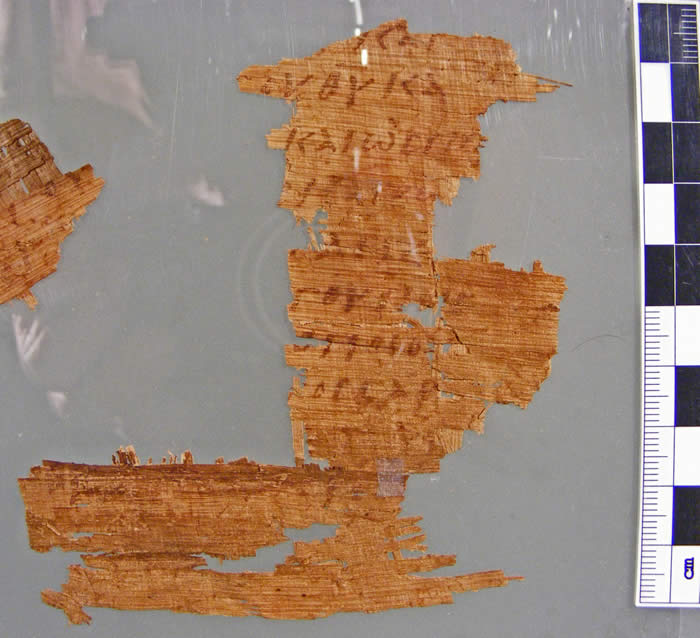
E16694 frg 3 verso has left margin, ditto [PG 26.1009];
frg 4 has parts of 3 lines from the left margin, and frg 11 has the last line and lower margin, but lines 4-9 (at least) must have had significant variants from the TLG text. For frg 4v see below!
?ργα το? Πατρ?ς, τα?τα λ?γει . . .
[about 24-25 lines missing from top of the page to the next preserved material]
μερ?ς μου ε? ?ν γ? ζ?ντων. ? δ? ?ερεμ?ας
λ?γει, ?τι ? πλ?σας τ? π?ντα,
01 α?τ?ς κληρονομ?α το? ?ακ?β, Κ?ριος
02 ?νομα α?τ?. Τ?ν ο?ν προφητ?ν
03 τ?ν Κ?ριον κληρονομ?αν
04 λεγ?ντων τ?ν ?γ?ων, ? Πα?λος τ?
05 ?γιον Πνε?μα κληρονομ?αν ε?ναι ε?πεν·
06 ?ν ?, φησ?, κα? πιστε?σαντες, ?σφρα-
07 γ?σθητε τ? Πνε?ματι τ?ς
08 ?παγγελ?ας τ? ?γ??, ? ?στιν ???αβ?ν τ?ς κληρονομ?ας ?μ?ν· ?ς κα? Μωσ?ς τ?
09 πρ?σωπον ?σφραγ?σθη τ? ?γ??
10 Πνε?ματι, ?τε ?λαβε ν?μον παρ? Θεο?,
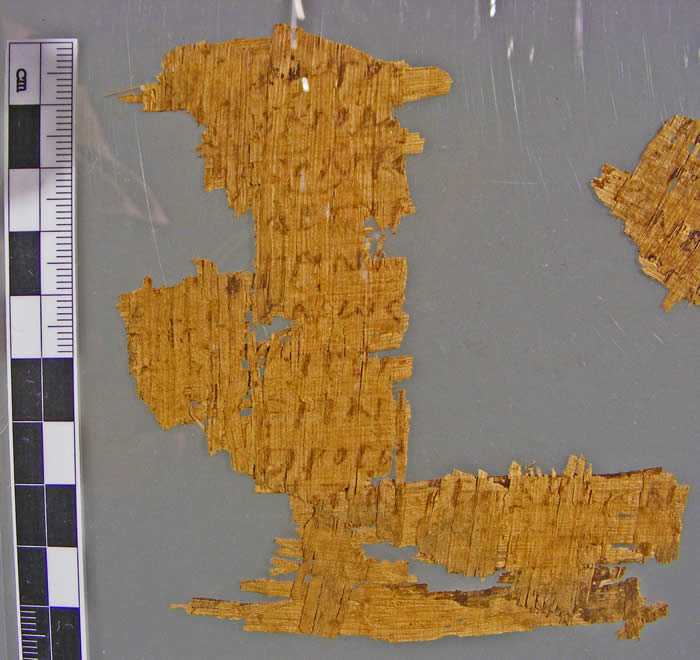
frgs 4 and 11 appear to be part of the same page as frg 3, but 4v indicates significant variation in lines 4ff.
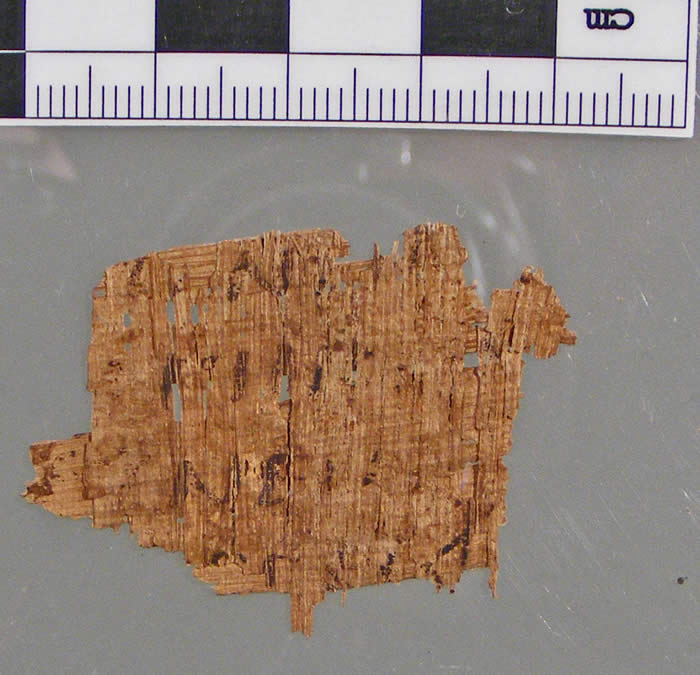
No identification has been made for frg 1 and the several smaller pieces.
Unfortunately, Colin Roberts had not seen fit to comment on the possible date of the hand -- pending closer computer examination, the frgs all seem to come from the same hand. My own relatively unsystematic probes thus far suggest that the paleographical date range is wide, from 4th to 7th (or even 8th) centuries. To say "6th to 7th" does not narrow things very much.
A physical description can be made with much more confidence. The Chrysostom pieces probably represent a page of about 33 lines, with an average of 25-30 letters per line. There are probably some minor textual variations, such as the absence of gar in two places.
The Marcellus (or is it Athanasius?) fragments are similarly formatted, with a similar number of lines per page (33-36), and about the same number of letters per line as the Chrysostom pieces. Of course, textual variants in the many missing lines could easily affect the respective page sizes. My suspicion is that they were basically the same format, perhaps the same codex. The usual "nomina sacra" seem to have been abbreviated in the usual manner for this period. The two Marcellus pages may have been the inner bicolon of a quire, or two consecutive pages at the break between quires.
What is the remaining large unidentified fragment (#1)? Are we dealing with a large codex or series of patristic codices, or possibly with a more modest book of excerpts of some sort? Your help is invited. How unusual is it to have such fragments on papyrus? Do we have other evidence for these authors "traveling together," as it were? What is this "Marcellus" text, and how is it associated with Athanasius?
As for the technological aspects of working with such materials, I intend to make the digitized images available for wider inspection if the University Museum will permit. My presentation to the Berlin Papyrological Congress, dealing with some non-literary fragments at the University's Center for Judaic Studies, illustrates how computer assisted maniputlation of the images can aid in the research.
//end; updated and transferred to html 30ja2009//